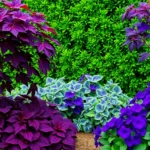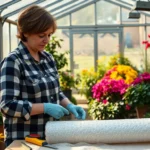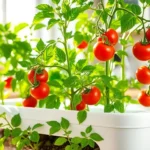Transform your outdoor space into a stunning sanctuary with the right garden slab choices. Whether you’re designing a cozy patio retreat or creating elegant pathways throughout your industry, selecting the perfect slabs can make all the difference in achieving your dream garden aesthetic.
We’ve discovered that garden slabs aren’t just functional elements – they’re design statements that define your outdoor living experience. From natural stone textures that blend seamlessly with nature to contemporary concrete designs that add modern flair, the possibilities are endless when you know what to look for.
Ready to elevate your garden’s style and functionality? We’ll explore creative slab ideas that work with any budget and design preference, helping you create outdoor spaces that’ll have your neighbors asking for your secret.
Natural Stone Slabs for Timeless Garden Elegance
Natural stone slabs bring an unmatched authenticity to garden spaces that synthetic materials simply can’t replicate. We’ve seen countless gardens transformed by the organic beauty and lasting durability these materials provide.
Limestone Slabs for Classic Appeal
Limestone slabs create sophisticated pathways and patios with their subtle cream and gray tones. We recommend choosing honed limestone for high-traffic areas since it provides better slip resistance than polished surfaces. Popular varieties include Indiana limestone and French limestone, both offering excellent weather resistance.
These slabs work exceptionally well in formal garden designs where consistent coloring matters most. Maintenance involves simple cleaning with pH-neutral stone cleaners every few months. Limestone naturally develops a beautiful patina over time, adding character to your outdoor space.
Consider using 24×24 inch limestone slabs for expansive patio areas or 12×24 inch pieces for intricate pathway designs. The neutral palette complements both traditional and contemporary landscaping styles.
Sandstone Options for Rustic Charm
Sandstone slabs deliver warm earth tones ranging from golden yellows to deep reds that enhance cottage-style gardens. We particularly favor Raj Green and Autumn Brown sandstone for their rich color variations and natural texture. These materials create inviting outdoor spaces with their inherently rustic appearance.
Installation becomes easier with sandstone’s natural split surface, which provides excellent grip underfoot. Weather resistance varies by sandstone type, with harder varieties like Yorkshire stone lasting decades in harsh climates. Softer sandstones require sealing every 2-3 years to prevent water damage.
Popular thickness options include 22mm for pedestrian areas and 32mm for areas with occasional vehicle access. The irregular edges of sandstone slabs create organic-looking joints that work beautifully with gravel or moss filling.
Granite Slabs for Modern Sophistication
Granite slabs offer unparalleled durability and contemporary aesthetics for upscale garden installations. We recommend flamed or brushed granite finishes for outdoor applications since they provide superior traction compared to polished surfaces. Common choices include Absolute Black, Silver Gray, and Sunset Gold granite varieties.
These premium slabs resist staining, scratching, and weather damage better than most natural stones. Professional installation ensures proper support since granite slabs typically weigh 15-20 pounds per square foot. The investment pays off through minimal maintenance requirements and exceptional longevity.
Standard granite slab dimensions include 12×12, 18×18, and 24×24 inch squares for modular installations. Linear slabs measuring 6 feet by 2 feet create striking contemporary walkways that complement modern architectural styles.
Concrete Garden Slabs for Budget-Friendly Solutions
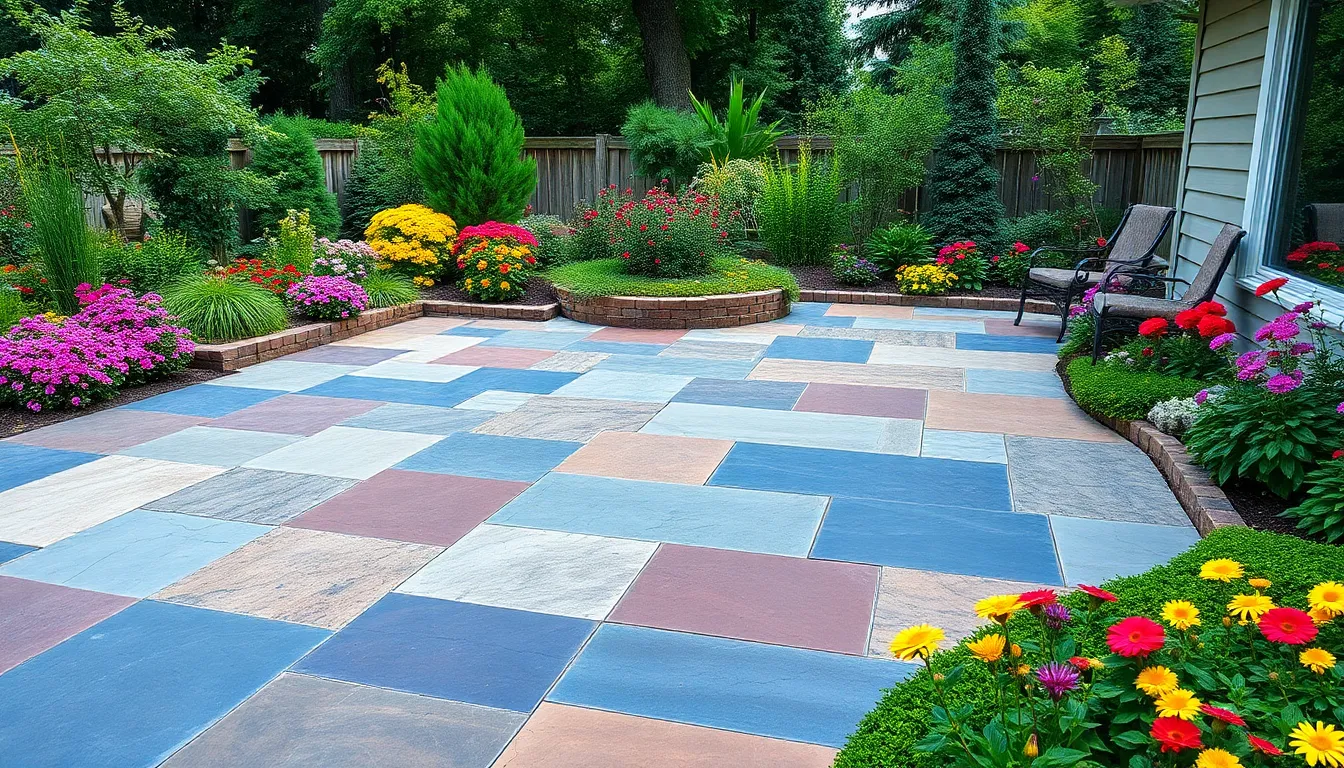
Concrete slabs present an excellent alternative to natural stone when we’re working within tighter budgets. These versatile answers offer durability and long-lasting performance while maintaining the visual appeal our gardens deserve.
Stamped Concrete Designs
Stamped concrete transforms ordinary slabs into stunning replicas of premium materials like stone, brick, or wood. Patterns get pressed into wet concrete using specialized stamps, creating realistic textures that mimic expensive natural surfaces. We can achieve the look of cobblestone pathways, slate patios, or wooden deck boards at a fraction of the cost.
This technique works particularly well for larger garden areas where natural materials would be prohibitively expensive. The versatility of stamped designs means we can match any garden style, from rustic cottage themes to sleek modern landscapes. Installation involves pouring concrete and applying stamps while the surface remains workable, making it a straightforward process for professional contractors.
Colored Concrete Variations
Colored concrete opens up endless possibilities for customizing our garden slabs to match existing hardscape features. Pigments get integrated directly into the concrete mix or applied as surface treatments, allowing us to achieve everything from subtle earth tones to vibrant accent colors. Popular choices include warm terra cotta, cool slate gray, and rich sandstone hues that complement natural plantings.
These color options resist fading and wear over time, maintaining their appearance through various weather conditions. We can create striking visual contrasts by combining different colored sections or use consistent tones throughout for a cohesive look. The coloring process adds minimal cost to standard concrete installation while significantly improving the overall aesthetic impact.
Textured Concrete Finishes
Textured finishes on concrete slabs provide both safety benefits and visual interest for our garden spaces. Brooming, scoring, and molding techniques create surfaces ranging from smooth to deeply textured, improving slip resistance in wet conditions. These finishes work especially well around pool areas, on garden steps, and along frequently used pathways.
We can combine textured surfaces with colored or stamped designs for added complexity and style. Common texture options include exposed aggregate, salt finish, and broom swept patterns that complement various garden themes. The added grip makes textured concrete ideal for high traffic areas where safety concerns outweigh purely aesthetic considerations.
Porcelain Slabs for Low-Maintenance Garden Spaces
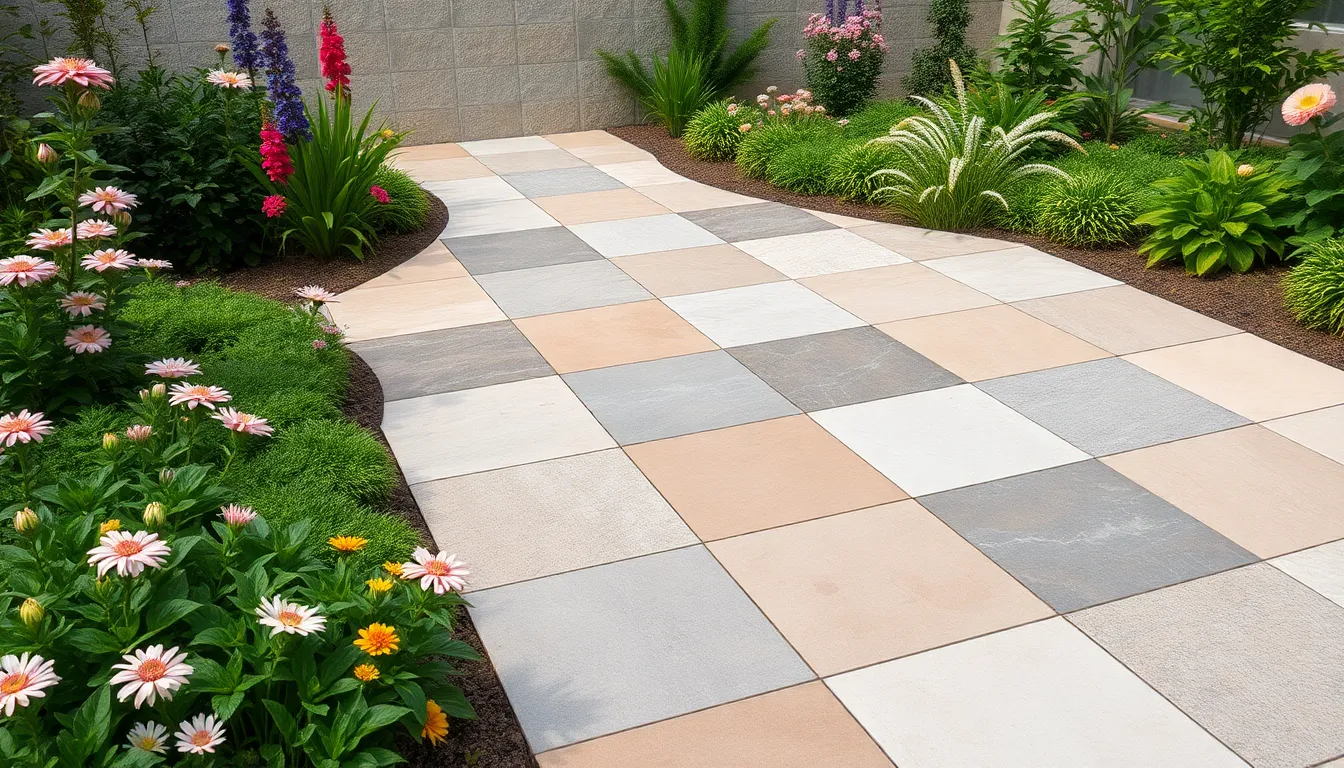
Porcelain slabs represent the perfect fusion of durability and style for homeowners seeking garden answers that require minimal upkeep. These innovative materials offer superior performance compared to traditional options while delivering stunning visual appeal.
Weather-Resistant Properties
Porcelain slabs excel in extreme weather conditions thanks to their impressive frost-proof construction and non-porous surface design. Their remarkably low porosity rate of just 0.5% creates an impenetrable barrier against moisture infiltration and stain absorption. Temperature fluctuations that would damage other materials have virtually no impact on porcelain’s structural integrity. Rain, snow, and ice simply cannot penetrate the surface, eliminating concerns about cracking or deterioration over time. We’ve found that these slabs maintain their appearance year after year, regardless of harsh climate exposure.
Contemporary Design Options
Porcelain slabs offer an extensive palette of colors, textures, and finishes that rival the most sophisticated design materials available today. Wood-grain patterns create authentic timber aesthetics without the maintenance headaches of real wood surfaces. Stone-look varieties replicate marble, granite, and limestone with stunning accuracy while providing superior performance characteristics. Sleek monochromatic options complement modern architectural styles, while textured surfaces add visual depth to any outdoor space. Customization possibilities allow us to match existing hardscape elements or create bold contrasting statements that enhance overall garden design.
Easy Installation Benefits
Professional installation maximizes porcelain slab performance, though their uniform dimensions and consistent patterns make DIY projects more manageable than with irregular natural stones. Precise manufacturing ensures each slab fits perfectly with adjacent pieces, eliminating the guesswork often associated with natural material installations. Lightweight construction compared to concrete alternatives reduces handling complexity and foundation requirements. Standardized sizing simplifies planning and ordering processes, while their durability means we get installation right the first time without worrying about future replacements or repairs.
Reclaimed Materials for Eco-Friendly Garden Design
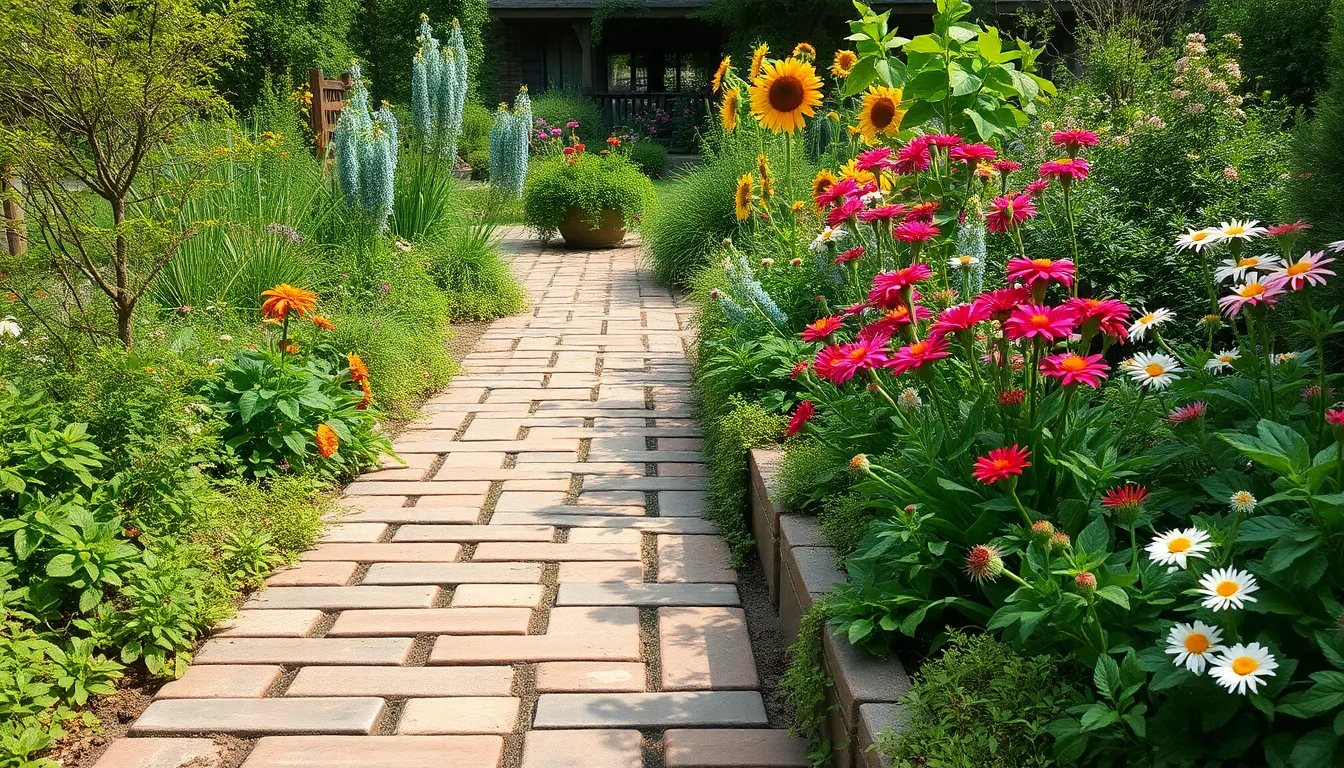
Building on sustainable practices, we can dramatically reduce our environmental impact by choosing reclaimed materials for garden slabs. These eco-friendly alternatives help us create stunning outdoor spaces while diverting waste from landfills.
Recycled Brick Slabs
Salvaged bricks from old buildings offer us a charming way to create rustic pathways and decorative borders in our gardens. We find these reclaimed materials particularly appealing because they add instant character while reducing landfill waste through material reuse. Weathered brick slabs work exceptionally well for cottage-style gardens where we want to establish a vintage aesthetic. Installing these materials requires careful selection since we need to ensure the bricks are structurally sound after years of use.
Reclaimed Wood Alternatives
Composite materials made from recycled plastics provide us with durable wood-look alternatives that withstand outdoor conditions better than traditional lumber. We appreciate how repurposed plastic lumber serves similar aesthetic purposes without the maintenance challenges of natural wood. These innovative materials resist moisture, insects, and decay while maintaining their appearance for decades. Manufacturing these alternatives from recycled content helps us support circular economy principles in our garden design projects.
Repurposed Stone Options
Natural stone salvaged from demolished structures gives us access to premium materials like granite, limestone, and sandstone at reduced costs. We benefit from the unique weathered character these reclaimed stones bring to our garden paths and decorative elements. Sourcing these materials from architectural salvage yards helps us avoid the environmental impact of quarrying new stone. Each piece tells a story while providing the durability and beauty we expect from natural stone installations.
| Material Type | Recycled Content | Primary Benefit | Best Use |
|---|---|---|---|
| Recycled Rubber Pavers | 100% recycled tires | Reduces landfill waste | Pathways and patios |
| Reclaimed Concrete Slabs | Construction site salvage | Decreases new material demand | Large paved areas |
| Reclaimed Bricks | Old building materials | Adds rustic charm | Decorative borders |
| Composite Materials | Recycled plastics | Superior durability | Wood-look applications |
Creative Layout Patterns for Garden Slab Installation
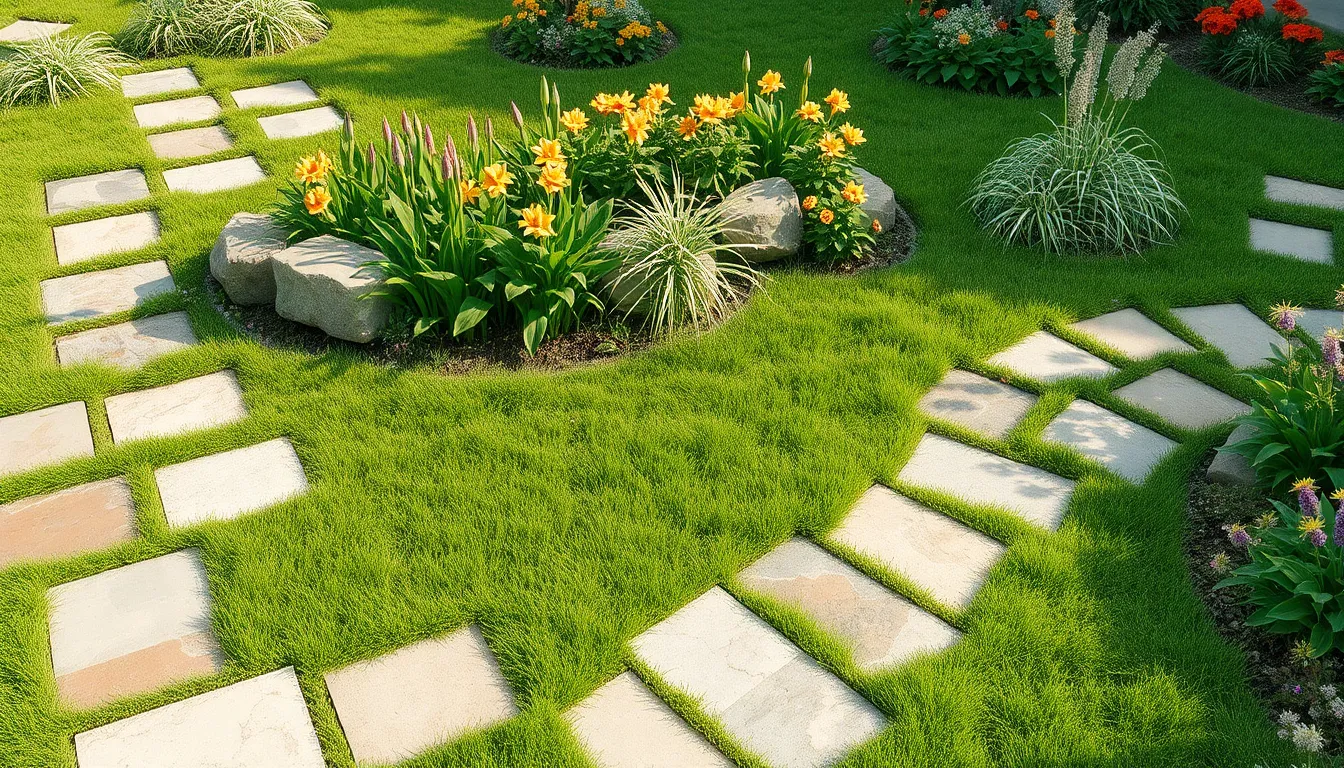
Once you’ve selected your ideal slab material, the next step involves choosing a layout pattern that maximizes both visual appeal and functionality. We’ll explore three popular arrangement styles that transform ordinary installations into stunning outdoor features.
Herringbone Pattern Arrangements
Herringbone designs create striking visual impact through their distinctive zigzag formation where slabs alternate direction at 90-degree angles. This classic pattern delivers exceptional stability for high-traffic areas while adding sophisticated texture to your garden space.
Installing herringbone arrangements requires precise measurement and careful planning to maintain consistent spacing throughout the design. We recommend starting from a central point and working outward to ensure symmetrical alignment across the entire installation area.
The interlocking nature of herringbone patterns provides superior structural integrity compared to straight-line installations. Garden pathways and patio areas benefit significantly from this enhanced stability, especially in regions with freeze-thaw cycles that can shift individual slabs over time.
Random Pattern Designs
Random layouts embrace organic irregularity by combining different slab sizes and shapes without predetermined arrangements. This approach mirrors natural stone formations and creates unique focal points that draw attention throughout your garden industry.
Planning random patterns involves selecting complementary slab dimensions that fit together harmoniously while maintaining adequate joint spacing. We suggest laying out your design on the ground before final installation to visualize the overall composition and make necessary adjustments.
Natural stone slabs work exceptionally well in random configurations because their varied textures and colors create authentic, weathered appearances. Mixing rectangular and square formats in different sizes produces the most visually interesting results while maintaining structural soundness.
Linear Layout Configurations
Linear arrangements offer clean, contemporary aesthetics through systematic slab placement in parallel or perpendicular alignments. Stack bond patterns, where slabs align in perfect grid formations, create modern minimalist designs ideal for urban garden settings.
Stretcher bond configurations provide subtle variation by offsetting alternating rows to produce staggered effects that reduce visual monotony. This traditional approach works particularly well with rectangular slabs and complements both contemporary and classic architectural styles.
Measuring and marking reference lines becomes crucial for achieving professional linear results that maintain consistent spacing and alignment. We recommend using string lines and measuring tapes to establish precise guidelines before beginning the actual slab placement process.
Mixed Material Combinations for Unique Garden Aesthetics
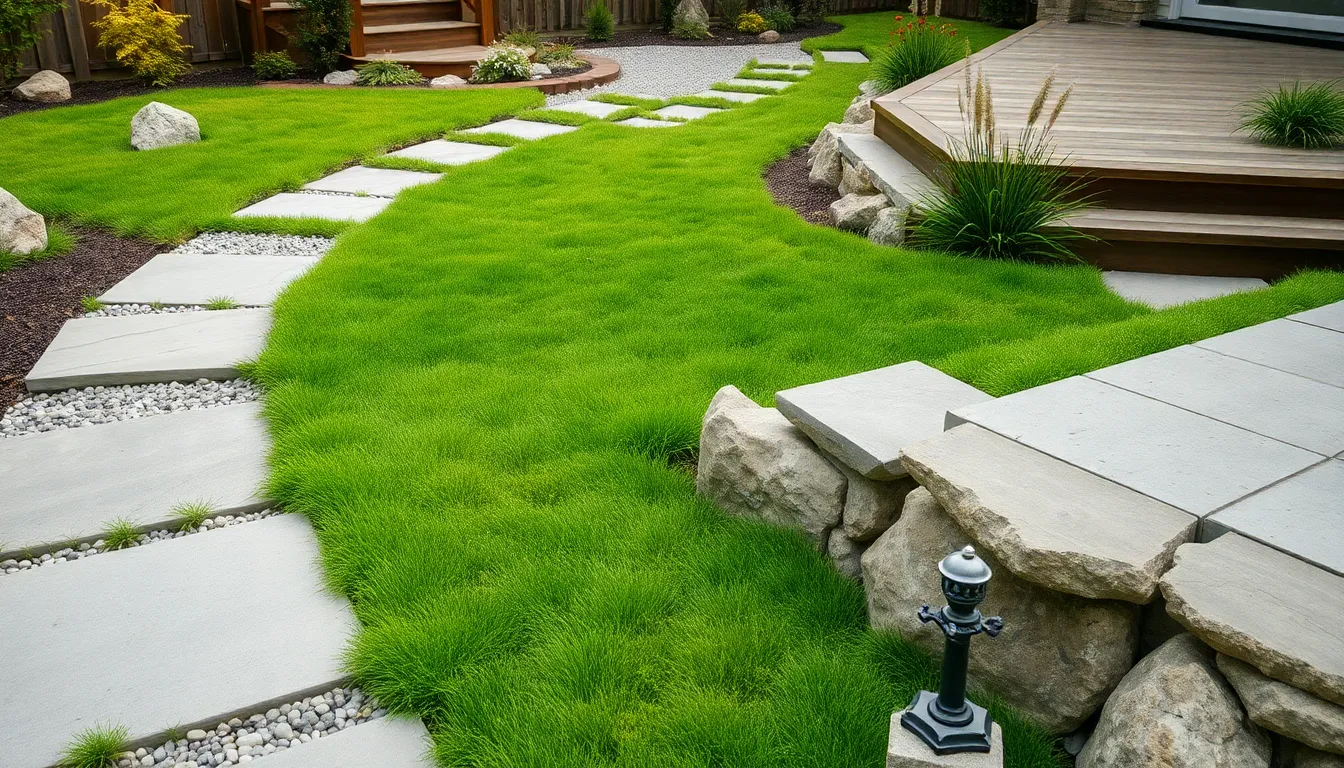
We’ll explore how combining different materials can transform your garden space into a stunning outdoor showcase. These thoughtful pairings create visual interest while maintaining functionality.
Stone and Gravel Combinations
Limestone slabs with gravel pathways create a sophisticated contrast that elevates any garden design. The natural stone provides solid walking surfaces while gravel fills gaps between slabs for superior drainage. This combination works particularly well in rustic gardens where the weathered texture of limestone complements loose gravel materials.
Granite pavers mixed with decorative stones offer a modern approach to traditional landscaping. We recommend using larger granite slabs as focal points with smaller river rocks or pea gravel creating transition zones. The hard surface of granite contrasts beautifully with the organic flow of gravel materials.
Natural stone borders with gravel infill define garden beds while maintaining permeability. Stone edging keeps gravel contained while allowing water to penetrate soil naturally. This pairing reduces maintenance compared to solid paving while preserving the structured appearance of formal garden designs.
Slab and Grass Integration
Grass strips between stone slabs create an eco-friendly pattern that expands visual space in smaller gardens. The alternating green and stone elements reduce the amount of hardscaping materials needed while maintaining walkable surfaces. This design approach works exceptionally well in contemporary gardens where clean lines meet natural elements.
Stepping stone patterns through lawn areas provide functional pathways without overwhelming grass coverage. We suggest spacing stone slabs at comfortable walking intervals while allowing grass to grow naturally around each piece. This integration maintains the soft appearance of lawns while creating defined traffic routes.
Checkerboard arrangements of slab and turf offer a striking geometric pattern that suits modern garden aesthetics. Square stone sections alternate with grass squares to create visual rhythm and reduce maintenance requirements. The pattern works best in areas with consistent sunlight where grass can thrive between stone elements.
Wood and Stone Pairings
Wooden decking combined with stone paving creates warmth through contrasting textures and materials. Natural wood softens the hard edges of stone while providing comfortable seating areas adjacent to durable walking surfaces. This combination suits gardens where entertaining spaces transition into landscaped areas.
Timber planks with concrete slabs offer a contemporary approach to mixed material design. The organic grain of wood contrasts with smooth concrete surfaces to create visual depth. We recommend using weather-resistant hardwoods or composite materials to ensure longevity when paired with concrete elements.
Stone pathways connecting wooden platforms establish clear circulation routes while highlighting different functional zones. Raised wooden areas serve as destinations while stone paths provide durable connections between spaces. This pairing works particularly well in sloped gardens where wooden decking creates level surfaces at different elevations.
Size Variations to Maximize Garden Impact
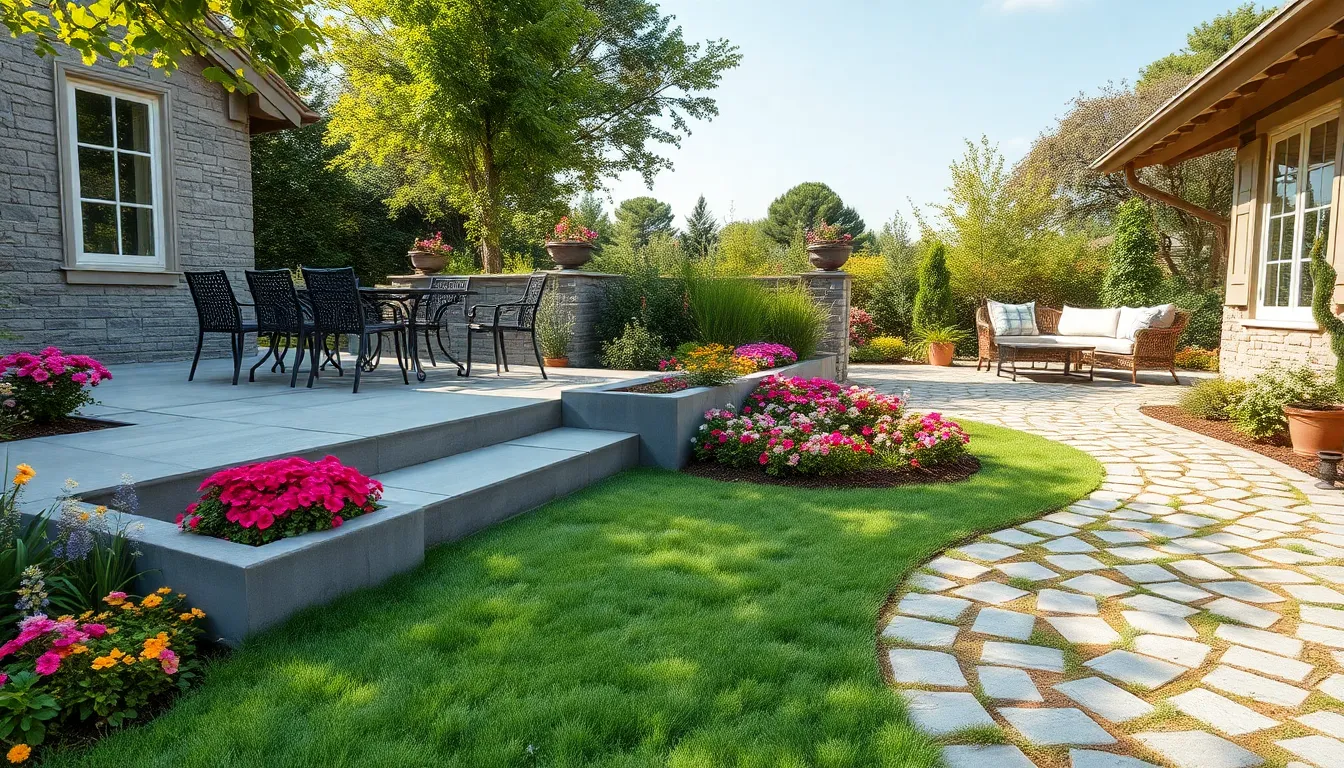
Strategic slab sizing transforms ordinary outdoor spaces into visually compelling landscapes. We’ll explore how different slab dimensions create distinct atmospheres and functional benefits throughout your garden design.
Large Format Slabs for Open Spaces
Large format slabs measuring 60 cm x 60 cm or larger work exceptionally well in expansive garden areas and formal patios. These substantial pieces create seamless continuity that makes gardens appear more spacious than their actual dimensions. We recommend using large slabs to establish smooth transitions between indoor and outdoor living spaces, effectively reducing visual clutter while highlighting your home’s architectural features.
Maintenance becomes significantly easier with fewer joints between slabs, minimizing weed growth opportunities and simplifying cleaning routines. Large format installations provide the perfect foundation for outdoor dining sets, lounge furniture, and entertaining areas where uninterrupted surfaces enhance both comfort and aesthetics. We’ve found that oversized slabs anchor design elements effectively, creating stable visual foundations that support other industry features.
Small Slab Designs for Intimate Areas
Smaller paving slabs, typically 30 cm x 30 cm or hexagon shaped options, excel at creating cozy, intimate garden atmospheres. These compact dimensions allow for intricate pattern development, including herringbone and basketweave arrangements that add visual rhythm to confined spaces. Winding garden paths benefit tremendously from small slab installations, as they navigate curves and irregular shapes with precision that larger formats cannot achieve.
Small slabs offer exceptional flexibility around garden beds, planters, and uniquely shaped areas where detailed work is essential. We recommend using these smaller formats for accent borders, stepping stone pathways, and decorative focal points that require careful attention to detail. Complex mosaic patterns become achievable with small slabs, enabling creative expressions that showcase your personal garden style preferences.
Mixed Size Arrangements
Combining large and small slabs maximizes both aesthetic appeal and practical functionality throughout your garden space. Large slabs anchor primary seating and dining areas, while smaller pieces define connecting pathways and decorative accents that guide movement naturally. This ever-changing approach creates textural contrast and visual character that breaks monotony while maintaining design cohesion.
Mixed arrangements accommodate varying garden functions seamlessly, from open entertaining spaces to secluded reading nooks that serve different purposes. We suggest using large format slabs for high traffic zones and transitioning to smaller pieces for detail work and accent features. Creative focal points emerge naturally when contrasting slab sizes work together, reinforcing your distinctive garden aesthetic while ensuring every area remains both visually appealing and purposefully designed.
Color Coordination Ideas for Garden Harmony

Creating visual unity throughout your outdoor space requires thoughtful color selection that complements your existing garden elements and architectural features.
Neutral Tones for Versatile Design
Neutral-colored garden slabs offer unmatched versatility for creating timeless outdoor designs. Beige, gray, and cream slabs blend seamlessly with most garden styles while providing a sophisticated foundation that never goes out of style. These understated colors make small spaces appear larger and brighter by reflecting natural light throughout the area.
Choosing neutral slabs provides several practical advantages:
- Flexibility allows you to change furniture or accessory colors without clashing with your hardscape
- Longevity ensures your design remains current through changing trends
- Compatibility works with both traditional and contemporary garden themes
We recommend neutral tones for homeowners who prefer classic elegance over bold statements. Their understated appeal keeps the focus on your plantings and garden features rather than competing for attention.
Bold Colors for Statement Areas
Bold-colored slabs create dramatic focal points that energize exact garden zones and demand attention. Bright hues like red, yellow, deep blue, and purple work exceptionally well for entertaining areas or garden rooms intended to impress guests.
Strategic placement of bold colors maximizes their impact:
- Border applications frame pathways and define garden boundaries
- Inlay patterns create artistic designs within neutral slab areas
- Checkerboard arrangements provide striking contrast against surrounding elements
We suggest using bold colors sparingly to avoid overwhelming your outdoor space. These statement slabs work best when balanced with plenty of neutral surroundings that allow the vibrant colors to truly shine.
Natural Hues for Organic Appeal
Natural hues create seamless transitions between your hardscape and the surrounding industry for an authentic outdoor experience. Soft greens, browns, and earthy grays blend harmoniously with the environment while mimicking the randomness of natural stone formations.
Natural-colored slabs offer practical benefits beyond aesthetics:
- Dirt resistance makes them ideal for high-traffic outdoor spaces
- Weather tolerance helps them maintain their appearance through seasonal changes
- Versatile mixing allows subtle color variations that enhance organic appeal
We find that natural hues work particularly well for cottage-style gardens and rustic settings where the goal is creating an understated, timeless look. Mixing slabs with subtle color variations further enhances this natural effect while maintaining visual coherence throughout your outdoor space.
Functional Applications Beyond Traditional Pathways
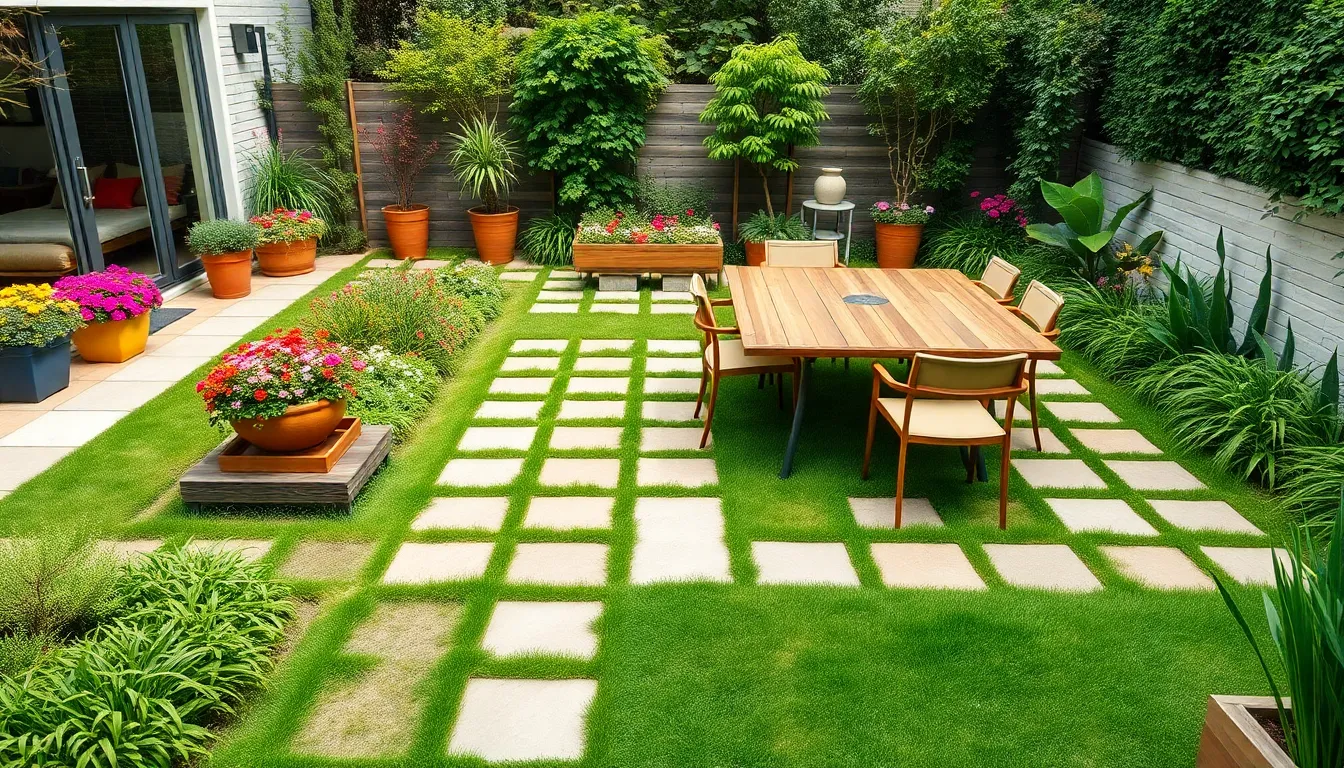
Garden slabs extend far beyond simple walkways to become versatile foundational elements that transform outdoor living spaces. We’ll explore innovative applications that maximize both functionality and aesthetic appeal.
Outdoor Dining Area Foundations
Creating inviting outdoor dining spaces requires thoughtful slab selection and arrangement to define entertainment zones effectively. We recommend using uniform slab sizes for formal dining areas or mixing varied dimensions to achieve a more relaxed, casual atmosphere that encourages longer gatherings.
Strategic color coordination enhances the dining experience by establishing visual boundaries between cooking and eating spaces. Lighter colored slabs reflect heat during summer months while darker tones absorb warmth for comfortable spring and fall dining sessions.
Proper spacing considerations ensure adequate room for furniture movement and guest circulation around dining tables. We suggest allowing minimum 36 inch clearances between slab edges and permanent garden features to accommodate chair placement and serving activities.
Garden Seating Answers
Defined seating areas transform ordinary garden corners into purposeful relaxation zones using strategic slab placement. Circular arrangements work exceptionally well for conversation areas while square or rectangular configurations suit reading nooks and meditation spaces.
Integrated planter borders around seating areas create natural boundaries that enhance privacy and visual interest. We position planters at strategic intervals to frame views while providing aromatic herbs or colorful flowers that engage multiple senses during relaxation time.
Multi level seating options use different slab heights to create natural amphitheater effects for family gatherings. Raised slab platforms serve as permanent benches while ground level installations provide stable foundations for moveable outdoor furniture.
Water Feature Surrounds
Framing water elements with carefully positioned slabs creates safety barriers while improving visual impact around ponds and fountains. We recommend extending slab installations 24 to 36 inches beyond water edges to provide stable maintenance access and viewing platforms.
Contrasting texture combinations pair smooth slab surfaces with rough materials like river rock or crushed stone to highlight water movement and sound. Natural limestone slabs complement curved pond edges while angular concrete varieties suit contemporary fountain designs.
Drainage integration beneath water feature surrounds prevents pooling and maintains structural integrity during heavy rainfall periods. We install proper drainage systems between slab joints to redirect overflow water away from seating areas and garden beds.
Conclusion
We’ve explored an extensive range of garden slab options that can transform any outdoor space into a stunning industry feature. From natural stone’s timeless elegance to modern porcelain’s low-maintenance appeal each material brings unique advantages to your garden design.
The key to success lies in matching your chosen slabs with your exact needs budget and aesthetic vision. Whether you’re drawn to eco-friendly reclaimed materials or prefer the consistency of concrete alternatives there’s a perfect solution waiting for your project.
Remember that creative layouts mixed materials and thoughtful color coordination can elevate even the most basic slab installation. We encourage you to experiment with different combinations and patterns to create outdoor spaces that truly reflect your personal style and enhance your home’s overall appeal.
Frequently Asked Questions
What are the best materials for garden slabs?
The best materials for garden slabs include natural stone (limestone, sandstone, granite), concrete, and porcelain. Natural stone offers authenticity and durability, with limestone providing slip resistance and sandstone offering rustic charm. Concrete is budget-friendly and versatile, while porcelain slabs are low-maintenance and weather-resistant. Choose based on your budget, style preferences, and maintenance requirements.
How do I choose between natural stone and concrete slabs?
Natural stone slabs offer unmatched authenticity, unique textures, and long-term durability but cost more and require regular maintenance. Concrete slabs are budget-friendly, available in various designs including stamped patterns, and work well for larger areas. Choose natural stone for premium aesthetics and concrete for cost-effectiveness and design flexibility.
What are the advantages of porcelain garden slabs?
Porcelain slabs offer exceptional durability, weather resistance, and low maintenance. Their non-porous surface prevents moisture infiltration and withstands extreme conditions without cracking. They’re lightweight with uniform dimensions, making installation easier. Plus, they come in contemporary designs including wood-grain and stone-look patterns that mimic premium materials while offering superior performance.
Can I use eco-friendly materials for my garden slabs?
Yes, eco-friendly options include recycled brick slabs that add rustic charm while reducing landfill waste, reclaimed wood alternatives made from recycled plastics, and repurposed stone from demolished structures. These materials provide unique character, reduce environmental impact, and often cost less than new materials while maintaining durability and aesthetic appeal.
What are the most popular slab layout patterns?
The three most popular layout patterns are herringbone, random, and linear configurations. Herringbone creates visual impact and stability for high-traffic areas. Random layouts embrace organic irregularity for unique focal points. Linear arrangements offer clean, contemporary aesthetics with systematic placement. Each pattern requires precise measurement and planning for professional results.
How do slab sizes affect garden design?
Large format slabs (60cm x 60cm or larger) work well in open spaces, creating seamless continuity and reducing visual clutter. Small slabs (30cm x 30cm) excel in intimate areas, allowing intricate patterns and flexibility around garden features. Mixed size arrangements combine large slabs for primary areas with smaller pieces for pathways and decorative accents.
What colors work best for garden slabs?
Neutral tones offer versatility and blend seamlessly with various styles while enhancing space perception. Bold colors create dramatic focal points and visual interest. Natural hues provide organic appeal that complements the environment. Choose colors based on your garden’s existing features, desired atmosphere, and overall design theme for optimal harmony.
Can garden slabs be used for more than pathways?
Yes, garden slabs are versatile and can create outdoor dining areas, seating zones, and water feature surrounds. They effectively define entertainment zones, enhance relaxation spaces, and frame water elements. Consider proper spacing, drainage integration, and color coordination when using slabs for these functional applications to ensure both aesthetic appeal and practicality.


